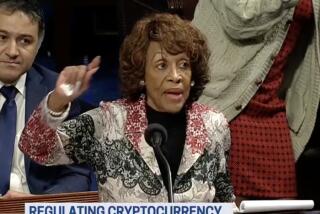We need a stronger Glass-Steagall Act to regulate financial firms
- Share via
“Bring back Glass-Steagall!” That’s the cry you hear most often for restoring regulatory stringency to our misbehaving financial sector.
The 1933 law, which barred commercial banks from underwriting or investing in stocks — in effect, from owning investment banks — was repealed in 1999, and reinstating it is a good proposal for several reasons. But what the 2008 financial crash and misadventures such as JPMorgan Chase’s multibillion-dollar derivatives loss tell us is that reinstatement of the old law isn’t enough. What we really need is a sort of 21st-century Glass-Steagall Act with a laser focus on the activities that threaten the financial system in the modern era.
The biggest threat comes from financial firms’ increased reliance on unregulated short-term borrowing, including fancy derivatives and money-market instruments that are vulnerable to panicky runs. In the old days, when Glass-Steagall was enacted, the only major form of short-term borrowing was bank deposits. That’s why they were specifically protected via the Federal Deposit Insurance Corp., another New Deal measure, which all but eliminated bank runs after its creation in 1933.
But the 1990s brought an explosion of new forms of short-term capital to the banking industry. This capital looked like deposits, in that it was cheap to acquire and subject to instant demands for redemption; investment banks and securities dealers got hooked on it because other forms of capital, such as equity, were more expensive. But the new funding sources aren’t insured like deposits, and their issuers haven’t been supervised the way the FDIC keeps its eye on deposit-taking banks.
The result, says Morgan Ricks, was the crash of 2008. Ricks, a former Treasury Department official now at Harvard Law School, proposes to update Glass-Steagall, in effect, by redefining banks as any institutions reliant on short-term capital and significantly tightening their regulation. In the recent past, those institutions included Bear Stearns and Lehman Bros., non-banks whose failures arguably launched the financial crisis.
“We think of the ultimate cause of the crash as [banks’] losses on mortgage assets,” Ricks told me recently. “But losses happen, and they’re not a big deal unless we have this unraveling in short-term markets. That’s what sends the economy into free-fall.”
The Glass-Steagall approach, he observes, doesn’t get at the core problem — Lehman Bros. was a pure securities firm, unaffiliated with a depository bank. “Yet its failure nearly brought down the whole financial system and the economy.” It may also be true that Glass-Steagall would not have prevented JPMorgan’s derivatives trading, which was conducted entirely on the commercial-bank side of the company — though it may yet turn out that the transactions crossed the line into investments forbidden to commercial banks under the old law.
Ricks proposes dividing financial firms into two categories. Those such as banks that want to live on deposits, “repos” and money-market funding would require a government license and be subject to stringent regulation of their safety and soundness. They’d be guaranteed a government bailout if things went wrong, but they’d also have to pay a stiff fee in advance for that guarantee.
Unlicensed firms wouldn’t be permitted to fund themselves in the short-term market — their capital would have to come entirely from the equity and bond markets. Nor would they be eligible for a government bailout. “We’d just let you go bankrupt if you fail,” Ricks says.
Indeed, there are plenty of examples of financial firms that failed without threatening the economy, because they had no short-term credit entanglements to spread the contagion. The commercial lender CIT Group, for instance, went bankrupt in 2009 with some $70 billion in liabilities — but because its capital came entirely from equity and debt, its failure caused scarcely a ripple in the financial markets and it promptly reemerged as a going concern.
Ricks’ proposal would have several positive effects. Securities firms forced to fund themselves in the long-term markets would be smaller albeit less profitable than today’s behemoths, solving the “too big to fail” problem at a stroke. Money market funds would probably fade away, because the new rules would make their business models untenable. They’d be unlamented by regulators such as Securities and Exchange Commission Chair Mary Schapiro, who said in February that these funds are so susceptible to panic-driven runs and so poorly supervised that we are “living on borrowed time” before a blowup in the sector threatens the stability of the financial markets.
Ricks’ identification of the collapse of short-term credit as the cause of the 2008 meltdown isn’t new or unique. (“Financial crises are always and everywhere about short-term debt,” contends University of Chicago economist Douglas Diamond.) But his proposal, as set forth in several legal discussion papers and an article in the New Republic in December, does point to new ways of thinking about financial regulation.
People tend to link the 2008 crash to the repeal of Glass-Steagall a decade earlier not because they’ve made a reasoned analysis of the connections between the causes of the financial crisis and the provisions of the old statute. Rather, they’re thinking metaphorically: The repeal symbolizes the rush of deregulation of the 1990s. That’s good thinking, because deregulation driven by lobbying by Wall Street and the banks in that era did set us up for disaster.
In 1991, Congress quietly succumbed to lobbying by Goldman Sachs and other Wall Street firms by giving the Federal Reserve new authority to make loans to securities firms in a crisis. The Fed narrowly averted having to put up money when the derivatives-laden hedge fund Long-Term Capital Management failed in 1998, but its active involvement in the firm’s rescue demonstrated its willingness to bail out securities firms if the financial system was at stake.
“Long-Term Capital underscored that the Fed was standing there ready to lend to non-depository institutions (that is, non-banks),” Ricks observes. “Once it became evident to the market that the Fed was ready to lend, it became a free option.” The bill came due in 2008, when the Fed lent millions to the failing Bear Stearns.
In 1998, in the wake of the LTCM collapse, Brooksley Born, the chairwoman of the Commodity Futures Trading Commission, proposed bringing credit default swaps and other risky derivatives under CFTC jurisdiction. Her plan was swept away by Fed Chairman Alan Greenspan, Treasury Secretary Robert Rubin and Securities and Exchange Commission Chairman Arthur Levitt. Congress soon exempted all over-the-counter derivatives from CFTC oversight. Spearheading the lobbying campaign: Enron.
Meanwhile Glass-Steagall was repealed, in large part because of the lobbying efforts of Citigroup, which had been created by the merger of the commercial bank Citicorp with the financial firm Travelers. The repeal retroactively legalized the merger.
The party was now underway. Financial regulators, whose tarot decks told them that stringent oversight would be frowned on by political leaders in both parties, tolerated high-risk developments in the financial industry, such as shrinking capital cushions and more carousing in the casino-like derivatives markets. Deregulation fed the assumption that the government would back up the financial sector in a crisis, even one of its own making. So firms got bigger and less risk-averse. The Glass-Steagall repeal is an appropriate shorthand for that phenomenon, and reinstating the law would be a clear signal that the party is over.
The virtue of Ricks’ regulatory model is that it sweeps away the distractions of history and aims itself at the root causes of the financial crisis, not merely the troublesome outcome. Now that he’s set forth his principles, the hard work begins to communicate them to policymakers.
“You’ve got to convince people in the world of ideas first,” he observes. “The reception has been positive, but the influence has been negligible.” Yet if the meltdown taught us anything, it’s that regulators need new tools to deal with new breakdowns. This is a good place to start.
Michael Hiltzik’s column appears Sundays and Wednesdays. Reach him at mhiltzik@latimes.com, read past columns at latimes.com/hiltzik, check out facebook.com/hiltzik and follow @latimeshiltzik on Twitter.
More to Read
Inside the business of entertainment
The Wide Shot brings you news, analysis and insights on everything from streaming wars to production — and what it all means for the future.
You may occasionally receive promotional content from the Los Angeles Times.











